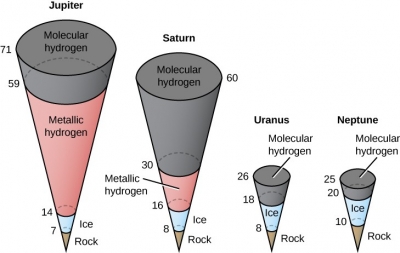
Neptune is the fourth largest planet in terms of diameter, making it the smallest in physical size of the gas giants. The average distance from the center of the planet to its surface is 15,299 miles (24,622 kilometers). But like most spinning bodies, Neptune’s rotation causes it to bulge slightly around the equator. The resulting shape is known as an oblate spheroid. The radius at the poles is 15,125 miles (24,341 km), slightly smaller than the equatorial radius of 15,388 miles (24,764 km). The average diameter across the planet is 30,598 miles (49,244 km), almost four times the diameter of Earth.
Although Neptune comes in fourth in terms of diameter, it ranks third in terms of mass, ahead of Uranus. The gas giant weighs in at 1.02 x 1026 kilograms, or 102 trillion trillion kilograms. It is more than seventeen times as massive as Earth.
The rock, ices, and gas that make up the icy giant fill a volume of 15 trillion cubic miles (62 trillion cubic kilometers), almost 58 times the volume of Earth.
The density of Neptune is 1.638 grams per cubic centimeter. The low density indicates that, like Uranus, its atmosphere is made up of more ices than Saturn and Jupiter, causing scientists to call it an “icy giant”. The distance to Neptune from the sun keep the planet’s temperature low through the year, although some astronomers suspect the planet originally formed closer to the star.
Despite hosting a significantly lower mass, Neptune’s surface gravity is second only to Jupiter.
Credit : Space.com
Picture Credit : Google




